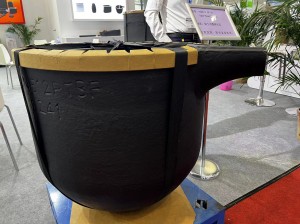
When conducting high-temperature chemical experiments or industrial applications, the choice of crucible material plays a vital role in ensuring the success and safety of the process. Two commonly used types of crucibles are clay graphite crucibles and graphite silicon carbide crucibles. Understanding its material composition, refractory temperature, chemical inertness, and thermal conductivity is critical to making an informed decision when selecting the appropriate crucible for specific laboratory or industrial needs.
material ingredient:
Clay graphite crucible is mainly composed of graphite, clay and a certain amount of lubricant, and is known for its chemical inertness. On the other hand, graphite silicon carbide crucible is made of silicon carbide powder and some rare earth oxides, and has the characteristics of high temperature resistance, excellent thermal shock resistance, and high chemical inertness.
Fire resistance temperature:
The refractory temperature of clay graphite crucibles generally reaches about 1200°C, while graphite silicon carbide crucibles can withstand temperatures above 1500°C. This makes graphite silicon carbide crucibles more suitable for applications requiring higher temperatures in chemical experiments and industrial processes.
Chemically inert:
Both types of crucibles exhibit a degree of chemical inertness, remaining stable in most acid, alkali, and salt solutions and resistant to corrosion. However, the clay component in clay graphite crucibles makes it easier to absorb trace elements and impurities compared to graphite silicon carbide crucibles.
Thermal Conductivity:
Graphite has high thermal conductivity and can dissipate heat quickly. However, due to the loose structure of the clay graphite crucible, black spots are prone to appear on its surface and require frequent cleaning. In contrast, graphite silicon carbide crucibles have a lower thermal conductivity and will not leave stains on the surface. In addition, their high hardness prevents wear and deformation.
Choose the right crucible:
When choosing a chemical laboratory crucible, specific requirements must be considered. Clay graphite crucibles are suitable for general chemistry experiments, while graphite silicon carbide crucibles are ideal for experiments requiring higher temperatures and more demanding conditions. It is important to strictly follow the instructions for use to avoid experimental failure due to improper operation.
In summary, understanding the differences between clay graphite crucibles and graphite silicon carbide crucibles is critical to choosing the most appropriate crucible for a specific laboratory or industrial application. By considering factors such as refractory temperature, chemical inertness and thermal conductivity, researchers and industrial professionals can make informed decisions to ensure the success and safety of experiments and processes.
Post time: Apr-25-2024
